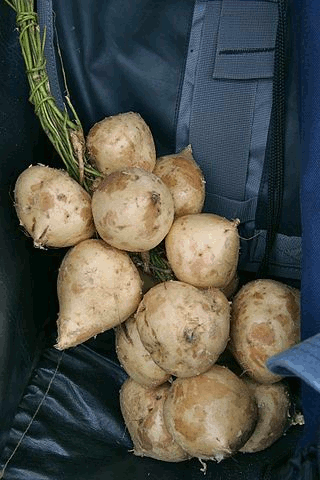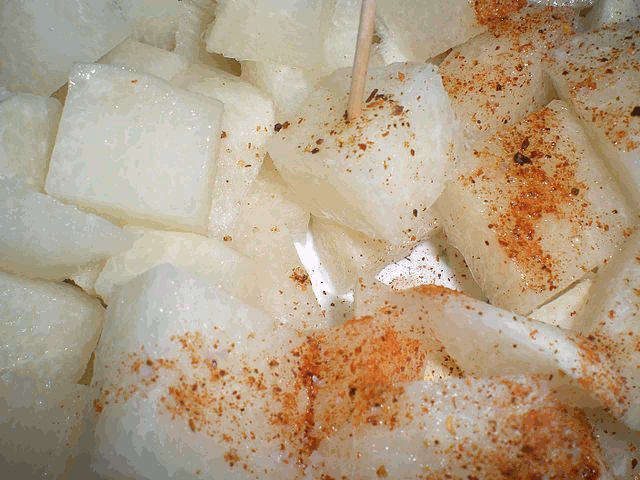Mexican Yam Bean
 Common Names: Mexican yam bean, Mexican turnip, jicama
Common Names: Mexican yam bean, Mexican turnip, jicama
Scientific Name: Pachyrhizus erosus
Climate: Warm and hot
Plant Description: The yam bean is a herbaceous legume plant with an edible tuber that comes from Mexico. It is turnip-shaped and light brown in color. It is white inside and crisp like a pear or raw potato. It is a vine plant that can grow up to six meters long. The green leaves are not edible. They have three serrated folios that grow from six to 12 centimeters long. The flowers are blue, about three inches long, and produce seeds that are poisonous.
There are two types of yam bean. The water yam bean has the round shape and produces a transparent juice, and the milk yam bean has a more elongated shape and the white juice. The water yam bean juice is usually sweeter.
Cultivation: The yam bean grows at altitudes up to 1,000 meters above sea level. It needs a moderate amount of water and grows best in full sun. It prefers moist, but well-drained soils.
To grow from seed, soak them in warm water overnight to soften the coat and facilitate germination. They should be planted about five meters deep, spaced 20 to 25 cm apart in rows 60 to 90 cm apart. In subtropical areas, it is sown in spring, while in tropical areas it can be sown all year round.
It is advisable to prune the plant to a meter or meter and a half high, including the flowers, to increase the growth of the roots. The tubers can be harvested after between four months and nine months. The later, the bigger they will be.
 Uses: It is generally eaten raw like a fruit. It is low in calories but rich in nutrients. It contains a fiber high in inulin that facilitates the absorption of calcium, thus strengthening the bones. It is also good for the digestive system. There are indications that it reduces the risk of colon cancer. It contains a high degree of vitamin C that improves immunity. It contains phosphorus, which improves the functioning of the kidneys.
Uses: It is generally eaten raw like a fruit. It is low in calories but rich in nutrients. It contains a fiber high in inulin that facilitates the absorption of calcium, thus strengthening the bones. It is also good for the digestive system. There are indications that it reduces the risk of colon cancer. It contains a high degree of vitamin C that improves immunity. It contains phosphorus, which improves the functioning of the kidneys.
Pests and Diseases: The yam bean does not typically have serious disease or insect problems. Pests that can affect the plant are the New World scarab and the wireworm. Ploughing or digging the land exposes the scarab to the rays of the sun and the birds. This method also works for the wireworm if done in summer as the larvae and eggs are very sensitive to high temperatures.
The yam bean can be affected by root rot if there is excess moisture.
References:
https://pfaf.org/user/Plant.aspx?LatinName=Pachyrhizus+erosus
https://www.verema.com/blog/productos-gastronomicos/1108171-que-jicama
https://www.ecured.cu/J%C3%ADcama
https://www.aboutespanol.com/la-jicama-un-tuberculo-muy-mexicano-806010
https://ecoinventos.com/jicama/
http://www.cesix.inifap.gob.mx/guias/JICAMA.pdf
https://www.intagri.com/articulos/fitosanidad/manejo-integrado-de-la-gallina-ciega
En español: Jícama
